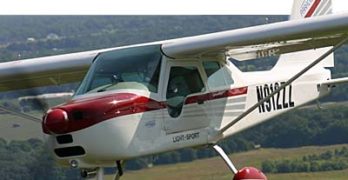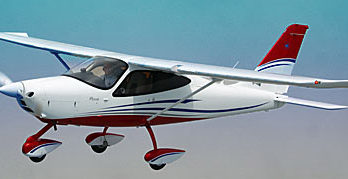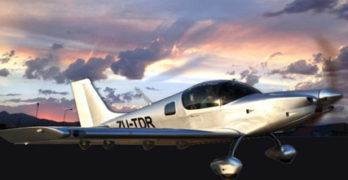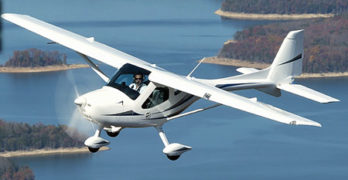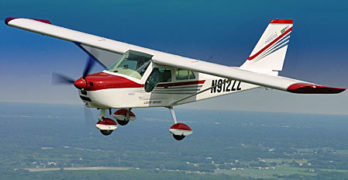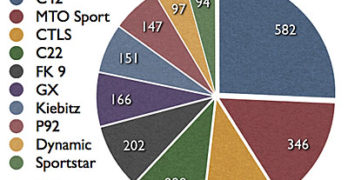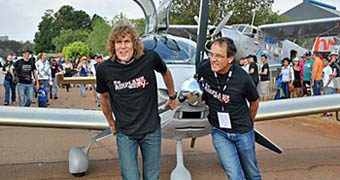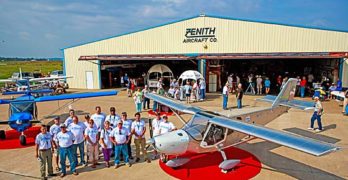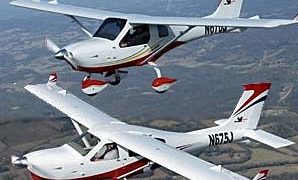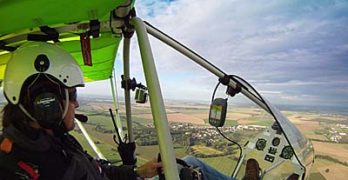Back a decade, soon to mark eleven years of operation the Sebring U.S. Sport Aviation Expo had a goal of putting the KSEF airport on the map. Doing so should attract business activity. Expo focused on the new segment of aviation — Light-Sport Aircraft — although it also included ultralights, lighter kit-built aircraft, and on occasion, conventional GA airplanes. It appears that 2014 is the year that goal was met. Sebring now claims longtime light airplane resident Lockwood Aircraft, added Tecnam of Italy in the spring with a major new facility, and in November garnered Paradise Aircraft of Brazil. The south of the equator company announced it had leased a 5,000 square foot hangar to launch their U.S. manufacturing and distribution operations. In a visit earlier this fall, Noe Oliveira told me that he was taking steps to build aircraft in Sebring for sale in the USA but also for export to other countries.
Tecnam’s Stellar 2014 … “10/90 Works!”
Italian company Tecnam has been a leading producer of Light-Sport Aircraft since the beginning of this newest aviation sector. Early distribution arrangements proved less than optimal so, like any progressive company, Tecnam retooled … and retooled again. In 2014 it appears they finally dialed in the correct lock combination. While keeping their friends at former distributor Heart of Virginia Aviation, they installed a factory presence at the top of the pyramid. A new factory-operated facility at the Sebring airport was announced at Sun ‘n Fun 2014. At the same time Shannon Yeager was hired to run the Florida center. As the year comes to a close, I called Shannon and asked for a summary of how things are going for Tecnam U.S. Inc. In particular I wanted to know how their 10% down program was working. When I first reported this, I found it a compelling answer to the concerns many American buyers have regarding the common need to send many tens of thousands of dollars overseas for an extended period of time.
LSA Taildraggers Broaden the Sector’s Appeal
Taildraggers may be among the least understood and most feared aircraft available in the LSA space … or for that matter throughout general aviation. While we have many good choices that I’ll list below, I have nonetheless heard from many readers or airshow visitors that they are uncertain about their operation of an aircraft that has no nosewheel. If you have no taildragger skills, you’ll also find it a challenge to get proper flight instruction in a “standard” aircraft. For those seeking new skills in flying, however, taildraggers may provide high satisfaction. Most who have crossed the barrier to taildragging subsequently look very fondly at such aircraft, seeing a sleeker yet gutsier, more rugged appearance. Of course, nosewheels dominate general aviation as they can be easier to land, especially in crosswinds, but once you learn the lesson of “happy feet” — or keeping your feet active on the rudder pedals throughout approach and touchdown — you may always yearn for more taildragger time.
Ownership Changes at Remos
This is one of those bad news—good news stories. The bad news for Remos Aircraft is being forced to file for what Germany calls “creditor protection” and what Americans might regard as bankruptcy. Tough times for the onetime high flying company that ran full page ads in America’s largest aviation magazines. The good news is that this is not the end of the story. A few weeks ago I heard through sources in Europe that Remos was filing documents to go out of business. In this case, the rumors turned out to be correct. However, shortly after the old company filed documents, a white knight stepped in to revive the company. This happened once before but this time the change of ownership has the experience of its predecessors. Remos AG is now emerging as the successor to Remos Aircraft GmbH Flugzeugbau. The company remains quartered in Pasewalk, located an hour’s drive northeast of Berlin.
P1NG … Fully Refreshed from Brazil
P1NG is not a sound nor golf equipment. The clever name (that’s a “1” not an “i”) is similar to a plane you know as the Paradise P1. Now get ready for the “Next Generation” P1, or simply, P1NG. The P1 you may have already seen was designed around a four-seat model with the aft cabin simplified to a luggage space. More on the entire family of Paradise airplanes below. P1 and P1NG offer more cubic area than most cockpits in light aviation. Besides a spacious cabin the front seats remove in a few seconds allowing an occupant to stretch out fully in its length. Alternatively, P1NG could easily carry golf clubs (you probably ought to load the American Ping brand), a family pet, camping gear, or anything else that fits within the weight & balance envelope. Though absent from the U.S. market for several years, Paradise reports good business in their native Brazil, a large and aviation-active country.
Germany’s Top 10 Ultralights by Aerokurier
Much of what we hear and know about airplane populations is centered on America. Yet in the world of sport and recreational aviation, the rest of the world equates to at least a 1:1 relationship, that is, for every American aircraft flying, many experts agree another flies internationally. It may be more significant than that … consider Germany.
In mid-August, our friends at Aerokurier, Germany’s leading aviation magazine, assembled an article about the top 10 ultralights in that country. A European ultralight, as you may know, is not the same as an American ultralight that is today limited to a single seat and no more than 254 pounds of empty weight. In Germany and elsewhere around the European Union, “ultralight” refers to an airplane much like a U.S. Light-Sport but limited in weight to 472.5 kilograms or 1,041 pounds.
Originally the weight limit had been 450 kilograms or 992 pounds but because emergency airframe parachutes are mandatory in Germany the weight was increased a few years ago to cover this component.
Sling 4-4-40 Flies After Four-Day Build
A couple days ago I wrote about the Sling 4-4-40 Challenge. I believe this to be of interest for a couple reasons. One is the fast build at an airshow … much like the intense interest surrounding EAA’s One Week Wonder (video) building of a CH-750 at Oshkosh. The other is my promise to offer coverage of the “New GA” or “LSA 4” planes — which are four seaters built by LSA companies using the technologies and techniques those companies know so well. South Africa’s Airplane Factory (TAF) Sling 4-4-40 challenge — in which a Sling 4 was built in 4 days by 40 workers — marked yet another milestone for the Sling manufacturer. What normally takes a kit builder 1,000 hours to complete, took place at the 2014 Africa Aerospace event in just four days. Build team leader and company boss Mike Blyth reported it took their team 854 hours from bare kit to flight, although painting and perhaps some interior finish will take a bit more time, a situation similar to the One Week Wonder project.
Open Houses, Airshow-Built Planes, and a Birthday
Last weekend Zenith Aircraft held another of their open house events. At the Midwest LSA Expo a few weeks beforehand I asked factory pilot guru, Roger Dubbert how many people the company expected. His answer: a rather amazing “700.” According to Zenith president Sebastien Heintz it was indeed another strong event, one they’ve repeated every year since setting up shop in Mexico, Missouri. “By all accounts and measurements, the 23rd annual Hangar Day was an incredible winner,” summarized Sebastien. Among the highlights of the two-day festivities was the arrival of EAA’s two Zenith aircraft. One was an EAA staff-built version of the CH 750 Cruzer (watch for our video pilot report to be posted soon) and the second was the One Week Wonder CH 750 that was completed during AirVenture with participation from over 2,500 people.
As Arion Aircraft‘s Nick Otterback put it, “Since this month seems to offer many open houses I wanted to share ours.
Fifteen Years for Jabiru USA; Celebrate and Save
In the Light-Sport Aircraft industry, many companies are celebrating fairly young birthdays, at least compared to 80-year-old legacy companies in the GA space. One of those is Number 8 ranked Jabiru, with more than 100 airplanes delivered in the USA. That is whole aircraft with that name, but remember, this is one only a very few companies that produces both airframes and engines under their brand. The U.S. outlet for the Australian brand (more on this below) announced, “Jabiru USA Sport Aircraft, LLC will celebrate its 15th anniversary the weekend of October 3rd through the 5th, 2014.” They sent out an invitation for all Jabiru owners, both aircraft and engine, as well as anyone interested in the lighter end of aviation to join them for a celebration. The company said it “will feature a Friday evening cookout with some fun & games, a Saturday breakfast fly-out to Winchester, TN, engine maintenance sessions Saturday morning and Saturday afternoon, a presentation on avionics updates including ADS-B, and a separate session on available engine updates.
Light Is Right In the Eyes of FAA and World CAAs
Evidently, a magic number exists to authorities in various civil aviation agencies around the developed world. That magic number — more correctly a range — is 115 to 120 kilograms, or 253 to 264 pounds. FAA led this charge way back in 1982 with the introduction of FAR Part 103 codifying that an airplane, ‘er … “ultralight vehicle” with an empty weight of 254 pounds — subject to certain exceptions for emergency airframe parachutes or float equipment — could be flown without three requirements common to all other aircraft. Part 103 vehicles• do not require registration (N-numbers); the pilots of these ultralights need no pilot certificate of any kind; nor do they need a medical. Such aircraft can be sold fully built, ready to fly. The entire regulation governing their use can be printed on the front and back of a single page of paper. This simply must be one of the most remarkable deregulatory efforts in all of aviation.
- « Previous Page
- 1
- …
- 6
- 7
- 8
- 9
- 10
- …
- 52
- Next Page »


